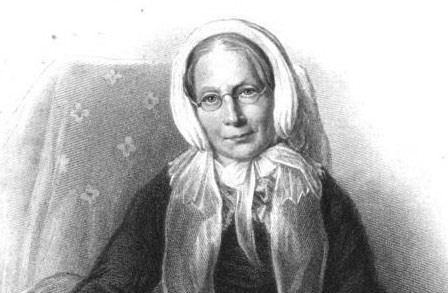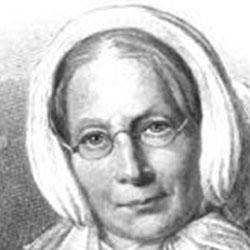Name Ann Taylor Role Poet | Books Rhymes for the Nursery Siblings Jane Taylor | |
 | ||
Died December 20, 1866, Nottingham, United Kingdom | ||
Ann Taylor (30 January 1782 – 20 December 1866) was an English poet and literary critic. In her youth she was a writer of verse for children, for which she achieved long-lasting popularity. In the years immediately preceding her marriage, she became an astringent literary critic of growing reputation. She is, however, best remembered as the elder sister and collaborator of Jane Taylor.
Contents

The literary family

The Taylor sisters were part of an extensive literary family, daughters of Isaac Taylor of Ongar. Ann was born in Islington and lived with her family at first in London and later in Lavenham in Suffolk, in Colchester and, briefly, in Ongar. The sisters' father, Isaac Taylor, was, like his own father, an engraver. He later became an educational pioneer and Independent minister and wrote a number of instructional books for the young. Their mother, Mrs (Ann Martin) Taylor (1757–1830) wrote seven works of moral and religious advice – in many respects liberal for their time – two of them fictionalized.
Ann and Jane's brothers, Isaac and Jefferys, also wrote, the former being a theologian, but also the inventor of a patent beer tap. The elder brother Charles Taylor edited The Literary Panorama, for which he wrote on topics from art to politics, and produced, anonymously, a massive annotated translation of Augustin Calmet's Dictionary of the Bible. His younger brother Josiah was a publisher, chiefly of works on architecture and design.
Authorship
The sisters and their authorship of various works have often been confused, usually to Jane's advantage. This is in part because their early works for children were published together and without attribution, but also because Jane, by dying young at the height of her powers, unwittingly attracted early posthumous eulogies, including what is almost a hagiography by her brother Isaac, and much of Ann's work came to be ascribed to Jane, a borrowing which, Ann ruefully remarked, she could ill afford and which Jane certainly did not require. It is true that Jane achieved much more than Ann as a writer of poetry for an adult readership – though Ann's poem "The Maniac's Song", published in the Associate Minstrels (1810), was probably the finest short poem by either sister, and it has even been postulated that it was an inspiration for Keats's La Belle Dame sans Merci (Lynette Felber: Ann Taylor's "The Maniac's Song": an unacknowledged source for Keats's "La Belle Dame sans Merci".
However, Ann also deserves to be remembered as a writer of prose, as evinced particularly by her autobiography and by the many letters of hers that survive. Her style is strong and vivid and, when she is not too preoccupied with moral and religious themes – like her sister Jane, she tended to pessimism about her own spiritual worth – it is often shot through with a pleasing and sometimes acerbic wit. The autobiography also provides much detailed and fascinating information about the life of a moderately prosperous dissenting family in the late 18th and early 19th centuries.
Appreciations
Ann Taylor's son, Josiah Gilbert, wrote:
"Two little poems – 'My Mother', and 'The Star', are perhaps, more frequently quoted than any. The first, a lyric of life, was by Ann, the second, of nature, by Jane; and they illustrate this difference between the sisters."
Both poems attracted the compliment of frequent parody throughout the 19th century. The logician Augustus De Morgan asserted (somewhat extravagantly) that Gilbert's mother wrote "one of the most beautiful lyrics in the English language, or any other language" and not knowing that Ann Gilbert was still alive, called upon Tennyson to supply a less heterodox version of the final stanza, which seemed to de Morgan unworthy of the rest.
Original Poems for Infant Minds by several young persons (by Ann and Jane and others) was first issued in two volumes in 1804 and 1805. Rhymes for the Nursery followed in 1806, and Hymns for Infant Minds in 1808. In Original Poems for Infant Minds the authors were identified for each poem. In Rhymes for the Nursery (1806) poems were not identified by author. Attributions for the sisters' poems can be found in an exceptional Taylor resource: The Taylors of Ongar: An Analytical Bio-Bibliography by Christina Duff Stewart. Stewart cites a copy of Rhymes for the Nursery belonging to a nephew, Canon Isaac Taylor, annotated to indicate the respective authorship of Ann and Jane. Stewart also confirms attributions of Original Poems based on publisher's records.
Marriage and widowhood
On 24 December 1813, Ann married Joseph Gilbert, an Independent (later Congregational) minister and theologian, and left Ongar to make a new home far from her family, at Masborough near Rotherham. A widower of thirty-three, Gilbert had proposed to Ann before he had even met her, forming a sound estimation of her character and intelligence from her writings, particularly as a trenchant critic in The Eclectic Review. Gilbert was, at the time of their marriage, the classical tutor at Rotherham Independent College – the nearest thing to a university open to dissenters at this time – and simultaneously pastor of the Nether Chapel in Sheffield. In 1817, he moved to the pastorate of the Fish Street Chapel in Hull and then, in 1825, to Nottingham, serving in chapels in the city for the rest of his life.
Kept busy with the duties of wife and later mother, Ann Gilbert still managed to write poems, hymns, essays, and letters. Her interest in public matters, such as atheism, prison reform, and the anti-slavery movement, often spurred her to take up her pen, and the results of those scattered moments found a way into print. Oddly for one of such independence of mind and strongly held and usually liberal opinions, she was firmly opposed to female suffrage.
After Gilbert died on 12 December 1852, Ann found time to write a short memoir of her husband. Nor did she spend the rest of her long life in gentle retirement. As well as actively supporting the members of her large family, through visits and a constant stream of letters – family was always of central concern to the Taylors – she travelled widely in many parts of Britain, taking in her stride as an old lady travelling conditions that might have daunted one much younger. She died on 20 December 1866 and was buried next to her husband in Nottingham General Cemetery, although the inscription recording this on the vast Gothic sarcophagus has disappeared.
